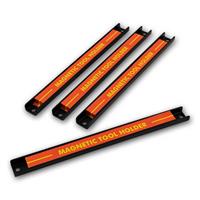Magnets
Magnets are a useful aid in daily life and often the only possible solution for fastening. If drilling and screwing is impossible, in many cases magnets in diverse shapes are employed, for example magnetic hooks and fridge magnets. However, there are also countless other practical tools, that utilize magnetism, like magnetic lifter, magnetic holder for small parts, magnet bars and other tool holders.
 Neodymium magnets, height 3mm, round magnets with Maxi Power
from
8.69 €
Neodymium magnets, height 3mm, round magnets with Maxi Power
from
8.69 €
 Neodymium magnet hook sets, magnets with super holding power
from
12.69 €
Neodymium magnet hook sets, magnets with super holding power
from
12.69 €
 Neodymium door lock magnets, 10 pieces, load capacity 2.7 kg
14.69 €
Neodymium door lock magnets, 10 pieces, load capacity 2.7 kg
14.69 €
Ferrit or neodymium – but not all magnets are the same!
Permanent magnets are available in various materials or alloys with different properties. The two most important are ferrit and neodymium magnets. These ones particularly differ in adhesive force and heat resistance. In fact, the adhesive power of ferrit magnets is low, but they are well suited for use in outdoor areas or at temperatures between +80 and +250°C. In contrast, most neodymium magnets can be used at temperatures up to – 40°C, but only up to + 80°C. At higher temperatures its magnetisation gets lost. Neodymium magnets are only suitable for interior use. In return they provide an enormous adhesive force at significantly smaller dimensions. Furthermore, they are visually more attractive thanks to its nickel-copper-nickel-coating. Prior to the purchase of a magnet, its intended purpose should be clarified, in order that the optimal matching magnet is employed.
Aspects that affect the adhesive power
Besides the field of application in terms of indoors or outdoors and the temperature also aspects like the surface quality, environmental influences, the load angle and the contact area of the objects to be held have a bearing on the magnet‘s adhesive force. Of course, magnets do not hold at surfaces made of aluminium or glass. In this case counter-magnets at the outside provide relief. In order that the magnet keeps it magnetisation for a long term, it should be protected from corrosion, einvironmental impacts like rain and solar radiation. Hook magnets, for example, unfold optimum adhesion attached to the underside of metallic surfaces and loaded vertically. Another load angle like on a wall reduces the holding force. Furthermore, the size of the contact area matters. Since obviously tools with thicker shaft or broad tool tips provide a better holding surface than thin round tool shanks.
Thanks to the great range of magnetic tools, no office has to remain untidy and there is no need to laboriously rummage for the suitable tool in workshops any longer. Practical helpers with magnets establish order and tidiness.















































